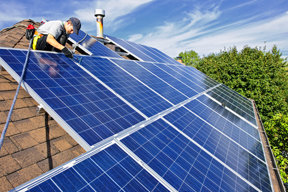Jochen Spengler had what he thought was a simple vision for the 22-unit condo building in which he lives in Hoboken, so he shared his vision with his fellow neighbors and the condo association. Spengler wanted to conserve condo association resources by saving water and energy costs in the small building’s common areas.
He proposed everything from installing energy-efficient light bulbs in the hallways to installing water-saving washers in the laundry room and solar panels on the roof. It took a lot of persuasion, but he eventually got the light bulbs and washers. Going solar, he discovered, was a harder sell.
“There were different roadblocks that I hit,” said Spengler, an electrical engineer, recently. “One was from the city permitting process. It took many meetings with the zoning officer, the buildings inspector, the mayor, the fire inspector, the electrical inspector. You name it. The permitting process basically took a year of meetings.”
The biggest challenge is perhaps the most obvious one: space.
________
Even if the ordinance is approved, however, urban residents who want to go green still face unique challenges not faced by their counterparts in suburban communities.
Unique challenges
The biggest challenge by far is space.
“Solar does take space. You need about 100 square feet to put up one kilowatt of electricity,” said Jeff Chavkin, president of Geoscape Solar. “You’re going to need at least 500 square feet to put up a five kilowatt system. An ideally placed five kilowatt system [on a pitched roof] could produce 6,000 kilowatt hours of electricity a year.”
To put that in perspective, 6,000 kilowatt hours, according to Chavkin, equals about $100 in energy costs a month, or about $1,000 a year.
A flat roof, he added, would require more space – 700 square feet – to produce the same amount of energy. (Flat roofs require more square footage because, Chavkin explained, they “have a greater wind uplift in the corners and on the sides” of the roof.)
Older roofs also pose a problem.
“I want [to work with a roof] that’s got at least 10 more years, if not 15, before it’s going to have issues. If a roof is old and is in bad shape, which you will find in places like Jersey City, Hoboken, then I won’t work with it,” Chavkin said. “That makes no sense because you’d incur the costs of installing the [solar] panels, then removing them for the roof repair, and then installing them again.”
Incidentally, the age of the building itself does not pose a problem. Solar installation companies like Geoscape, Chavkin said, can easily work with old buildings that have newer roofs that are in good shape and won’t need to be replaced within the next decade.
Permanent obstructions on rooftops, such as air conditioning systems, sky lights, and vents – which are common on city roofs – also pose a problem, Chavkin said, because they cast shadows and block sunlight.
“Everything that’s on a roof will cast a shadow. So, you have to work around that,” he said.
Despite the challenges, Chavkin said he gets calls every day from prospective clients in Hoboken and Jersey City.
“They’ll ask me, ‘Can I do a solar system?’And the answer is, ‘it depends.’”
Solar: It’s not for everyone
And then there’s the communal nature of most city residences.
Owners of single and two-family homes that go solar realize their cost saving quickly and can take advantage of many incentive programs that exist at both the state and federal levels.
The savings are more nebulous for condo associations that install solar panels.
“That is the problem with solar. It doesn’t work for everyone,” said Hoboken resident Thomas Chartier, owner of Chartier Redevelopment Group, located in the city. “It usually works for low-rise buildings that have a lot of roof area, relative to the total square footage of the building. So, single family homes can usually take advantage of it. Condo buildings are a real gray area. Once you get [bigger than] 5 units, there are no incentives for you to do it, until you get to be a 60 to 70 unit building.”
Solar arrays installed on communal properties, like condos, will impact the energy costs in the communal spaces – such as the hallways, foyer, basement, or laundry room – but do not impact the energy costs of individual condo units, a concept that Spengler said his neighbors in Hoboken found difficult to grasp.
In the end, Spengler decided to go it alone. He formed his own limited liability company and he’ll pay the costs associated with installing the solar arrays on his building – then sell the energy back to his condo association at a reduced rate.
His neighbors, he said, “don’t believe this is going to work. They’re looking for the catch. They think it’s some kind of scam.”
E-mail E. Assata Wright at awright@hudsonreporter.com.
